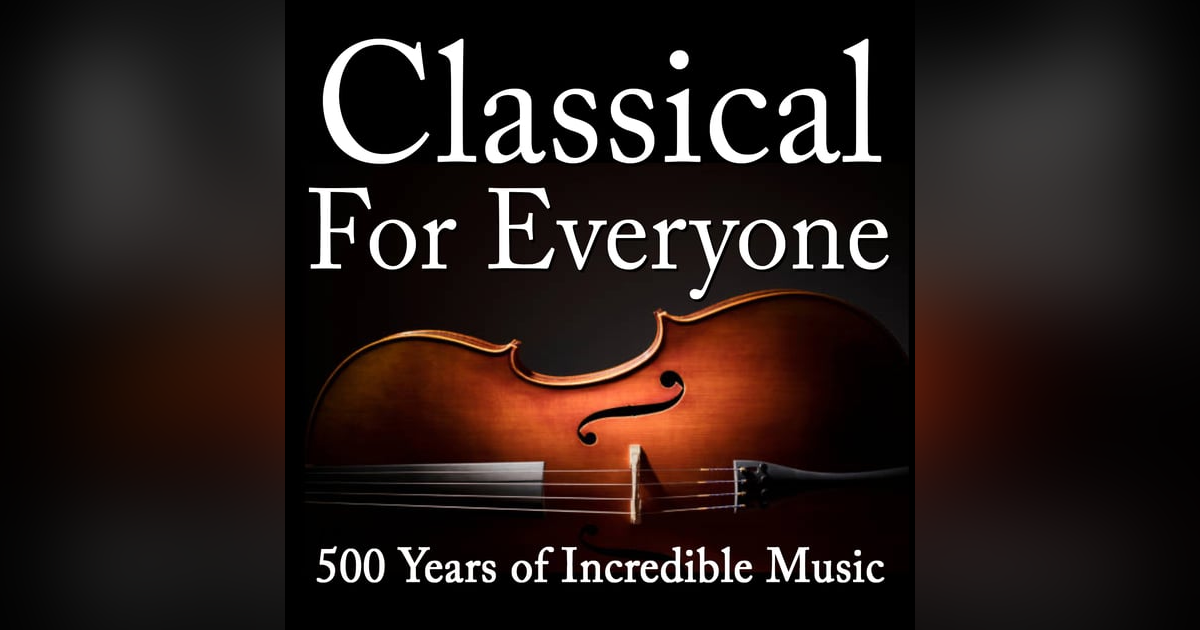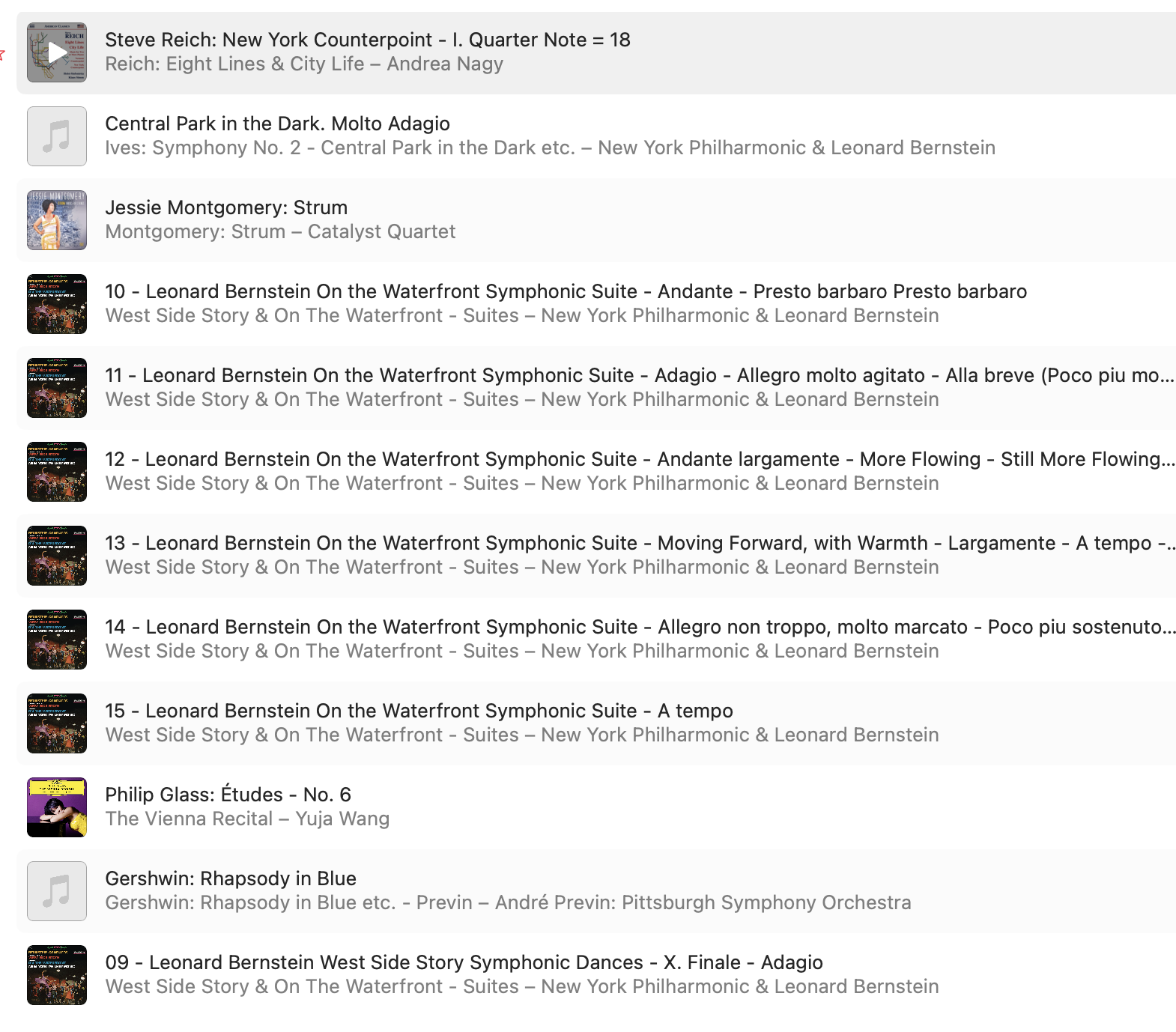New York... Sounds of a City

Why New York? Well, mainly because I love the city… and I’m here. I’m recording this episode in a hotel room on West 56th Street in Manhattan around the corner from Carnegie Hall and up the road from The Museum of Modern Art… which is incidentally a very popular place to make TikTok videos. I think there might still be some paintings there… but it was hard to tell today. More importantly… the music in this episode is from Steve Reich, Charles Ives, Jessie Montgomery, Leonard Bernstein, Phillip Glass and George Gershwin.
And here is a link to an extended playlist on Spotify with the full versions of most of the music in the episode:
https://open.spotify.com/playlist/0vHuX8EkkU1J23sBijQaM7?si=91f3ffa5b80b4115
The Music
The Words
Hello everyone. Welcome to another episode of the ‘Classical For Everyone’ Podcast… five hundred years of incredible music. My name is Peter Cudlipp and… If you enjoy any music at all then I’m convinced you can enjoy classical music. All you need are ears. No expertise is necessary. If you’ve ever been curious about classical music… or explored it for a while once upon a time… or just quietly wondered what all the fuss was about… then this is the podcast is for you.
And because there’s a lot of music out there each episode has something of a theme. And for today it is… classical music from New York City. Why New York? Well, mainly because I’m here. I’m recording this episode in a hotel room on West 56th Street in Manhattan around the corner from Carnegie Hall and up the road from The Museum of Modern Art… which is incidentally a very popular place to make TikTok videos. I think there might still be some paintings there… but it was hard to tell today.
So, New York. I could and might do an episode on the composers and musicians who lived here in New York for a time or wrote significant pieces here… people like Dvorák, Mahler, Rachmaninoff and Stravinsky. But for this one I want to concentrate on music that is very directly about New York and generally made by people who call or called New York home.
So, in the next hour you will hear music by Steve Reich, Charles Ives, Jessie Montgomery, Leonard Bernstein, Phillip Glass and George Gershwin. And I promise I’m not being deliberately obscure but I think there is a good chance some of this music will be unfamiliar to you.
So first up is Steve Reich. He was born in NYC in 1936 and In the early 1960s he was one of the pioneers of what came to be called minimalism… which the good people of Wikipedia describe as music that…“employs limited or minimal musical materials. Prominent features of minimalist music include repetitive patterns or pulses, steady drones, consonant harmony, and reiteration of musical phrases or smaller units.”
It is hard to underestimate the impact this movement has had on classical music of the late 20th century and to an extent the first quarter of this century. In one sense it was a way out of the dead end, especially in terms of audience engagement, that post-WWII European music had found itself in.
Here is the first part of Reich’s ‘New York Counterpoint’ from 1985 written for a solo clarinettist playing live against ten pre-recorded clarinet and bass clarinet parts. Out of that rather extreme recipe Reich has made a quite wonderfully musical statement. And I think there is something to the propulsiveness that reflects the never ending sense of movement in New York. In this performance all the clarinets are played by Andrea Nagy. It is about 5 minutes long.
A
That was the clarinettist Andrea Nagy performing the first section of Steve Reich’s ‘New York Counterpoint’. Next up in this New York episode of the Classical For Everyone podcast I am, for the first time, replaying a piece from an earlier episode. You’d think with all the music out there I could avoid repeating myself but this bit of music is too good and too relevant to ‘New York’.
As exemplified by Steve Reich, whose work I just played, after WWII New York would become a centre for innovation, experimentation and the extreme avant-garde. But fifty years earlier there was a man working away in the insurance industry in New York and composing music at night who was already at the absolute forefront of musical innovation.
His name was Charles Ives and he was decades ahead of his time. Just one example… I think you can say he invented what today is thought of as ‘sampling’. His music abounds with multiple instances of direct quotations of popular music of his day. Not just an influence or a borrowed melody but a recognisable fully expressed sample… frequently used for quite a jarring effect.
In 1906 he wrote a 7 minute piece for small orchestra he called ‘Central Park In the Dark’ and he described it this way… This piece purports to be a picture-in-sounds of the sounds of nature and of happenings that men would hear some thirty or so years ago (before the combustion engine and radio monopolized the earth and air), when sitting on a bench in Central Park on a hot summer night.
So, in a sense the sound world Ives is creating is Central Park in the 1870s about a decade after the end of the Civil War... Most of the piece is very quiet as Ives wants there to be a sense that the sounds are off in the distance.
Here is Leonard Bernstein conducting the New York Philharmonic. Charles Ives’ ‘Central Park in the Dark’.
B
That was Leonard Bernstein conducting the New York Philharmonic in Charles Ives’ ‘Central Park in the Dark’. So from the oldest piece in the episode to the most recently composed. Jessie Montgomery is a violinist and composer who grew up on the Lower East Side and studied at Julliard and New York University and was recently composer-in-residence for the Chicago Symphony Orchestra. In 2012 she wrote a piece for String Quartet called ‘Strum’ and on her website she describes the piece this way…
The strumming pizzicato serves as the primary driving rhythmic underpinning of the piece. Drawing on American folk idioms and the spirit of dance and movement, the piece has a kind of narrative that begins with fleeting nostalgia and transforms into ecstatic celebration.
It is about 7 minutes long and here it is performed by the Catalyst Quartet. Jessie Montgomery’s ‘Strum’.
C
That was the Catalyst Quartet performing Jessie Montgomery’s ‘Strum’.
Ok. Putting together an episode of classical music from New York there is one figure who rather towers above all others and whose work has to be in a pretty central place. That figure is Leonard Bernstein. Even without the burst of attention Bradley Cooper’s film ‘Maestro’ brought to Bernstein a couple of years back; he would still… 35 years after his death… arguably be the central figure of classical music in New York in terms of impact, reputation, popularity and legacy. So, what to play you? There is a lot to choose from but I’ve decided on the orchestral suite he adapted from the score he wrote for Elia Kazan’s 1954 film ‘On The Waterfront’. Even though Bernstein won an Academy Award for it, the script, the acting, the directing and the cinematography all seem to be thought of before the music. So it perhaps does not get its due.
And in an episode about New York, to take advantage of the memories some listeners might have of the film’s evocation of the city’s troubled waterfront is perhaps not the worst idea. And if you don’t know the film then maybe you are actually in a better position to just enjoy this music filled with drama and beauty without distraction. Here is the composer, Leonard Bernstein, conducting the New York Philharmonic Orchestra with his Suite from ‘On The Waterfront’. It is about 19 minutes long.
D
That was Leonard Bernstein, conducting the New York Philharmonic Orchestra with his Suite from his score for the film ‘On The Waterfront’.
I was checking what I’ve played over the last six months and the man who was for a time the quintessentially downtown Manhattan composer, that is Philip Glass, has been pretty well represented so I am going to cruelly opt for just three minutes from his over six decades of work. This is his Piano Etude No. 6 from 1996. And this is a performance by New York resident Yuja Wang
E
That was Piano Etude No. 6 by Philip Glass performed by Yuja Wang.
My name is Peter Cudlipp and you have been listening to the ‘Classical for Everyone’ Podcast. I have another couple of pieces coming up but before I get to them I want to give you a little information that I hope you find useful…
If you would like to listen to past episodes, of which there are more than a dozen, or get details of the music I’ve played please head to the website classicalforeveryone.net. That address again is classicalforeveryone.net. And on the individual episode pages of the website there are links to Spotify playlists with the full versions of most of the music played in each of the episodes.
I hope you have enjoyed this New York focused episode of ‘Classical For Everyone’. If you want to make sure you don’t miss the shows as they are released then please Subscribe or Follow wherever you get your podcasts. And if you want to get in touch then you can email… info@classicalforeveryone.net.
Alright, to finish this episode I have something maybe a little more predictable… music written in 1924 that can be thought of as a fantasy for piano and orchestra and that has come to be pretty strongly identified with New York City… with the city’s energy and sense of possibility… George Gershwin’s ‘Rhapsody in Blue’. Commissioned in 1924 by Jazz Band leader Paul Whiteman for a concert in New York he called ‘An Experiment in Modern Music’; Gershwin wrote the piece in about five weeks with the orchestration done by Ferdie Grofé who had been arranging works for the Whiteman group for several years. Here is André Previn as piano soloist and conductor with the Pittsburg Symphony Orchestra. George Gershwin’s ‘Rhapsody in Blue’.
F
That was André Previn as piano soloist and conductor with the Pittsburg Symphony Orchestra. George Gershwin’s ‘Rhapsody in Blue’. Thanks for your time and I look forward to playing you some more incredible music on the next ‘Classical For Everyone’.
This podcast is made with Audacity Software for editing, Wikipedia for Research, Claude for Artificial Intelligence and Apple, Sennheiser, Sony, Rode and Logitech for hardware… The music played is licensed through AMCOS / APRA. Classical For Everyone is a production of Mending Wall Studios and began life on Radio 2BBB in Bellingen NSW, Australia thanks to the late, great Mr Jeffrey Sanders. The producers do not receive any gifts or support of any kind from any organisation or individual mentioned in the show. But, never say never.
And if you have listened to the credits… here is a little more music for you… I really couldn’t resist putting in just a moment from Leonard Bernstein’s Symphonic Dances from ‘West Side Story’. This is the finale… a slow and moving reworking of the beautiful song ‘Somewhere’. Thanks for listening.
